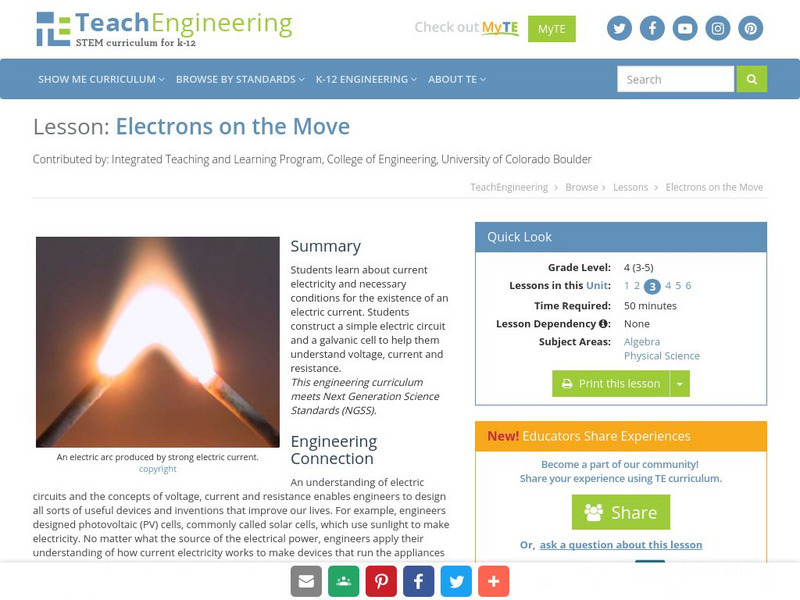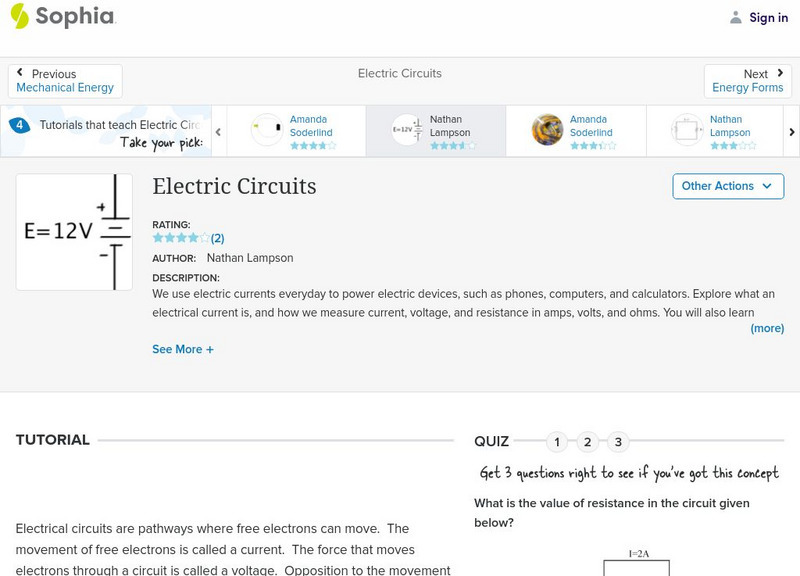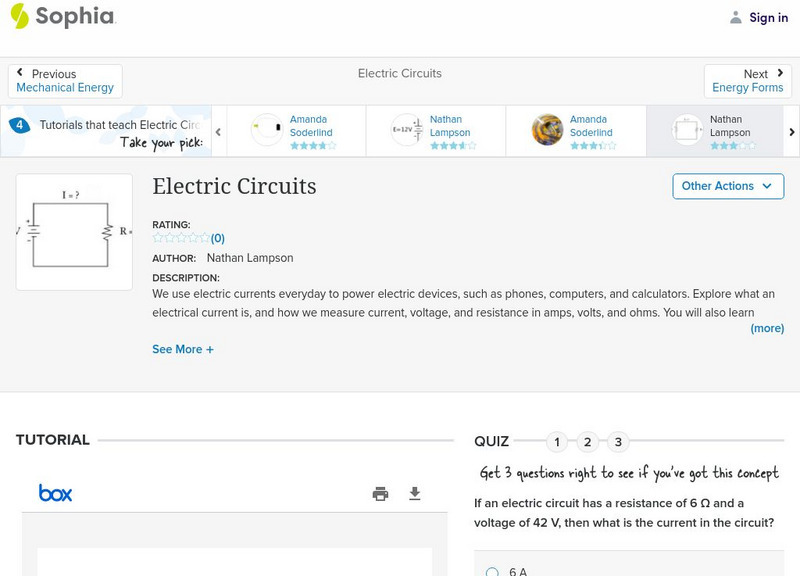Ducksters
Ducksters: Kids Science: Electricity 101
Kid's learn about the basic science of electricity. What is it and how it works.
Science Buddies
Science Buddies: Dance Mania: Build Your Own Dance Pad!
The objective of this electricity and electronics science fair project is to build a dance pad that flashes lights when you step on it.
Science and Mathematics Initiative for Learning Enhancement (SMILE)
Smile: Series and Parallel Circuits
A teacher lesson plan which could be easily converted into an idea for a student project or presentation. Ideal for pre-high school students. This page describes an activity in which the history of electric circuits, the nature of...
Science and Mathematics Initiative for Learning Enhancement (SMILE)
Smile: Batteries and Bulbs
For the teacher planning a lesson plan or for the student preparing for a project or presentation. This page describes an activity in which parallel and series circuits are constructed using batteries and bulbs. Complete activity...
Science and Mathematics Initiative for Learning Enhancement (SMILE)
Smile: Resistances in Series and Parallel Circuits
A teacher lesson plan is provided here. This page describes two activities in which the effect of multiple resistors on the current and overall resistance of both series and parallel circuits are investigated. Complete activity...
Physics Aviary
Physics Aviary: Rl in Ac Lab
This lab was designed to help students understand the difference between circuits powered by DC and circuits powered by AC. Students can see that simple changes in frequency lead to changes in the potential difference across the...
Khan Academy
Khan Academy: Dc Circuit and Electrical Power Review
Review the components of a circuit and their symbols such as battery, resistor, and switch. Analyze how the power of a resistor is related to the current and electric potential difference across the resistor.
Concord Consortium
Mobile Inquiry Technology: Parallel Versus Series Circuits
For this lesson, students actively investigate the differences between parallel and series circuits and how the brightness of bulbs is affected.
Physics Aviary
Physics Aviary: Rc in Ac Lab
This lab was designed to help students understand the difference between circuits powered by DC and circuits powered by AC. Students can see that simple changes in frequency lead to changes in the potential difference across the...
Massachusetts Institute of Technology
Mit: Open Course Ware: Current, Resistance, and Power
Learners investigate current, resistance, and power. Some topics explored in the activities are Ohm's law, electrical power, and solving circuits. The resource consists of video clips, lecture notes, online textbook chapters, exam...
TeachEngineering
Teach Engineering: Electrons on the Move
Students learn about current electricity and necessary conditions for the existence of an electric current. Students construct a simple electric circuit and a galvanic cell to help them understand voltage, current and resistance.
Khan Academy
Khan Academy: The Circuit Elements of a Simple Defibrillator
This is a five-question quiz related to circuit elements of a simple defibrillator.
Khan Academy
Khan Academy: Calculations From Circuit Diagrams
Practice calculating potential difference, resistance, and current for a component from a circuit diagram.
Khan Academy
Khan Academy: Using Voltmeters & Ammeters to Measure Potential Diff and Current
Practice identifying the correct placement of voltmeters and ammeters to measure an unknown circuit or electric potential difference for a circuit.
Concord Consortium
Concord Consortium: Dc Circuits: Series Resistances (Sparks 1)
This interactive simulation guides you through the wiring of the standard breadboard and presents you with questions regarding voltage drops and currents in series resistive circuits.
Concord Consortium
Concord Consortium: Dc Circuits: Series Parallel Resistances (Sparks 3)
Answer questions regarding voltage drops across resistors and currents through them in such circuits. Practice calculating the effective resistances of a set of resistances in series and parallel.
Khan Academy
Khan Academy: Electric Potential Difference and Ohm's Law Review
Review the key terms, equations, and skills related to Ohm's law, including how electric potential difference, current, and resistance are related.
Khan Academy
Khan Academy: Resistors in Series and Parallel Review
Review how to find the equivalent resistance for resistors in parallel and series configurations. Recall the current and voltage properties of series and parallel configurations of resistors.
CK-12 Foundation
Ck 12: Physical Science: Thermal Conductors and Insulators
[Free Registration/Login may be required to access all resource tools.] Thermal conductors and insulators and the ways they are used.
Khan Academy
Khan Academy: Calculating Equivalent Resistance for Series and Parallel Resistor
Practice finding the equivalent resistance for parallel and series resistor configurations in this four-problem quiz.
Sophia Learning
Sophia: Electric Circuits: Lesson 2
This lesson will explain how to calculate voltage, current, and resistance in simple electric circuits. It is 2 of 4 in the series titled "Electric Circuits."
Sophia Learning
Sophia: Electric Circuits: Lesson 4
This lesson will explain how to calculate voltage, current, and resistance in simple electric circuits. It is 4 of 4 in the series titled "Electric Circuits."
Science Buddies
Science Buddies: Which Materials Are the Best Conductors?
There are two main types of materials when it comes to electricity, conductors, and insulators. What are they made of? Find out by testing different materials in a circuit to see which ones conduct the most electricity.
BioEd Online
Bio Ed Online: Neural Network Signals
Nervous system messages are sent as electrical signals along the length of axons and dissolved salts are important for electrical signaling in cells. In this lesson young scholars are introduced to this concept by creating an electrical...






















